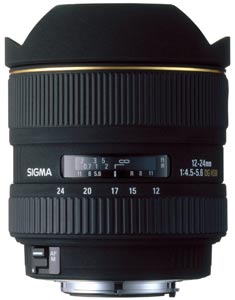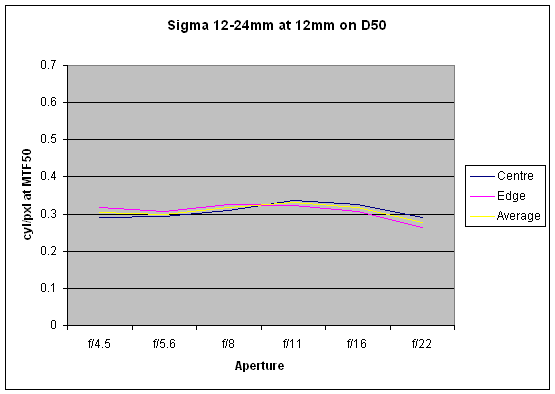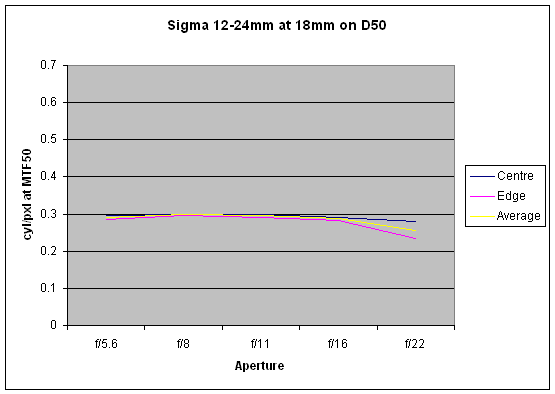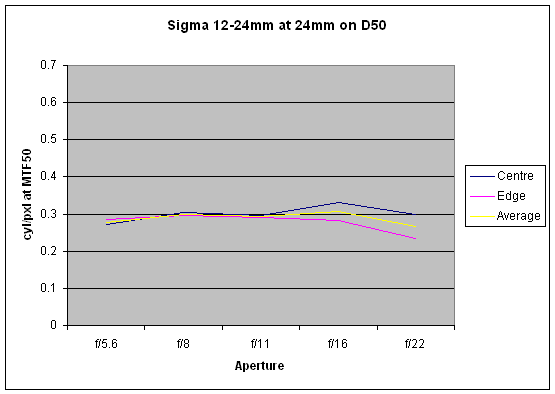Sigma 12-24mm f/4.5-5.6 EX DG
This ultra-wide angle zoom lens from Sigma projects an image circle big enough for full frame digital/35mm and is still very wide on a cropped sensor. We take a look at how it performs.
 Specifications
Specifications
- Model Sigma 12-24mm f/4.5-5.6 EX DG
- Focal length 12-24mm
- Max aperture F/4.5-5.6
- Min aperture f/22
- Construction 16/12 elements/groups
- Angle of view 122-84.1°(Full frame)
- Min Focus 0.28m
- Filter size Rear Gelatine
- Dimensions 87x102.5mm
- Weight 0.6kg
- Mounts available Sigma, Canon, Nikon(D) (with HSM), Sony, Pentax (without HSM)
Price (SRP) £569.99
Build and handling
Sigma invented the concept of wide-angle zooms with the ‘Zoom Gamma 21-35mm f/3.5-4.2’ in 1979. Prior to that the wide angle zoom category did not exist with the market consisting only of standard and telephoto zooms. In the intervening years, Sigma have managed to stay at the front end of the technology in the category and in this lens have managed to keep their place with the lens winning numerous awards including EISA Lens of the Year. As the widest corrected zoom generally available, with an angle of view at the wide end of 122 on full frame sensors or film, and distortions kept down to an absolute minimum it is an amazing piece of optical engineering.
Marketed as one of Sigma’s EX range, it sports the hardwearing matt black finish and gold band that signifies its status. That status is enhanced by the fact that Sigma UK offer an extended three year warranty with their EX lenses, a confidence in them that is commendable.
The lens has a fixed, petal hood with a slide on lens cap. This is as much to protect the convex front element as to protect the images from flare, something that it does commendably.
For the most part, the Sigma 12-24mm lens is a standard type of construction with two control rings, one for the zoom and one for the focus. Both operate smoothly with nicely balanced torque, neither too stiff nor too loose and between the two of them sits a neat distance window marked in both metres and feet. The edge of the distance window is marked with a conventional depth of field scale which shows that, at f/8, everything from half a metre to infinity should be within the acceptable realms of sharpness. The aperture range on the lens stops down to f/22 but this shows that, even on cropped sensor cameras which the lens is capable of being used on, depth of field is never going to be a problem past f/11.
Although the lens does not change its overall dimensions as you zoom, the front element does rack in and out slightly under the fixed hood and there is no conventional filter thread. Instead, the lens uses gelatine filters that can be cut to size and shape using the supplied template. These are then fitted into a spring-loaded slot on the rear element of the lens prior to fitting the lens on the camera. This can be a slight pain if you are still using film, where balancing filters are often needed but with the joys of digital RAW capture, where white balance can be adjusted post capture, there is no real hardship. There have also been one or two ingenious contraptions invented for attaching effect filters to the front of the lens although there is no proprietary method.
Optical quality
All of the usual anomalies, such as chromatic aberration and ghosting are well controlled throughout both the zoom range and the aperture range. Flare can be induced in any lens, especially one as wide as this one is, but the control of it is very well handled and when it does occur, it does not wreck the contrast of the whole frame.
The one area where, with a lens of this type and extreme angle of view, that you would expect to see problems are in the area of distortion. With the wide angle of view, some noticeable distortion could well be acceptable even so. However, the lens showed no signs of this problem and even when measured it proved to be well inside acceptable limits. At the longer end of the zoom range, a figure of –0.257% barrel distortion is given while at the wider, 12mm end a figure of –1.13%, again barrel, is produced by Imatest. Both figures are well inside the threshold of 1.5% where the phenomenon becomes visible to the naked eye. These results are truly remarkable given the amount of correction needed.
A look at the resolution charts shows that resolution is consistent from wide open to well past the f/11 mark before reciprocity kicks in. As we have said in these pages before, the DG coating Sigma applied to all of their lenses recently has knocked a lot of the “lacks contrast” remarks on the head and this is another lens that has benefited. Contrast has a perceptual effect on perceived sharpness, giving images a punchier look.
 With restricted access and a fence in the way, the extreme wide angle was the only way to include the top of the mast but exclude the fence. |  The huge depth-of-field obtainable means that this image is sharp from the chocks in the foreground through to infinity. f/11 and 14mm on D200. |
Click on each comparision photo below to view full size versions
Below is our lens test data. To find out how to use these graphs look at this article: How we test lenses



Verdict
A huge field of view, coupled with a sensible zoom range that is still useful on cropped sensor cameras as well as the full frame that it is designed for make this lens extremely practical. A great item of award winning kit, especially if you use more than one format of sensor.
In summary, the positive points of the Sigma 12-24mm f/4.5-5.6 EX DG are:
![]() Enormous field of view
Enormous field of view
![]() Amazing control of distortions
Amazing control of distortions
![]() Solid build quality with good protection of front element
Solid build quality with good protection of front element
The negative points of the lens are:
![]() Difficult to use front mounted filters (Though not impossible)
Difficult to use front mounted filters (Though not impossible)
![]() Bulbous front element needs careful handling.
Bulbous front element needs careful handling.
Get the latest price for the Sigma 12-24mm f/4.5-5.6 EX DG here
Discuss this lens and other related lens subjects here
Test by Ian Andrews www.wildaboutkent.co.uk
Dennis Fisher
Santa Maria, CA
--Mike
You've got to be kidding! I own this lens and while I have been pleased with its overall performance - the distortion, as mentioned is vanishingly small, an almost miraculous design effort - I simply can't believe the statement about flare. This lens flares worse than any other lens I've ever used. Shooting into the sun this lens regularly produces a line of 10-15 purple flare spots. It is essentially impossible to use with the sun or any other similarly bright highlight in the frame. These spots are also nearly impossible to clone out of a frame, even if one is willing to accept the compromises associated with such action.
Another unusual characteristic of this lens is that its images require considerably higher doses of USM to deliver a satisfying result than similar lenses. This is even true compared to Sigma's relatively similar 10-20 design. I can't explain it, and it does not even make sense to me, but I regularly push the USM scale much, much higher with images from this lens than I do with any other. Without such treatment the images tend to look soft. Why these results don't yield horrible halos or other artifacts I cannot explain, but in the end it does not cost more to push the slider further for this lens, and the results are good. Note that raw files produced by this lens tend to look quite soft, and without some persistence in post processing, one could easily be disappointed with the results.
Results on film (Nikon F5, Velvia/Provia) are stunning, not so much because of performance (which is reasonably good, even in the corners) but because of the astonishing perspective that is very hard to get with any other lens. The perspective of a 12mm lens on 35mm frame (122 degrees diagonal) must be seen to be believed. Oddly enough, despite the soft appearance on digital raw files, there is no such problem on fine-grained film.
Brian Wong
Gordonsville, Virginia
blw's comments on flare are quite right. This lens does have an extreme tendency to flare and even worse, produce VERY obvious 'ghosting' where bright light sources or spectral hilights are including in the frame. However, considering the extreme design of this lens at it's widest setting, it is still an impressive beast!
David Chamberlain
If you have to use it for professional results like I do, you have to know how to squeeze the most out of it. BLW's comments are first class, here some additional remarks. Myself, I find having to use it ALWAYS at f/16, even f/11 gives me a serious drop in resolution. But at f/16 and giving a stronger than normal USM (Raws in ARC: 100~150%/radius 0.7~1/detail 15) it holds well even on the very demanding Mark II. Extreme corners get awful at 12mm whatever you do, so be creative and put some solid, textureless matter in them (skies is the obvious outside solution for top corners, bold walls and floor do fine in interiors).
I love this lens more than any other for its astounding lack of distortion paired with such wide view.
Add your message
Please login here or if you've not registered, you can register here. Registering is safe, quick and free.
photodo Stats
428 MTF tests
74 in-depth photodo reviews
100+ users join each day
Help the lens community by reviewing or rating a lens today via our lens search
Latest Lens Reviews
- Chinon 28mm f/2.8 Vintage Lens Review
- Canon EF 70-200mm f/4L IS II USM Lens Review
- Samyang AF 85mm f/1.4 EF Review
- Sigma 70mm f/2.8 DG Macro Art Review
- Samyang AF 24mm f/2.8 FE Review
- Meike 50mm f/1.7 Review
- Tamron 70-210mm f/4 Di VC USD Review
- Lensbaby Burnside 35mm f/2.8 Review
- Asahi Super Takumar 50mm f/1.4 Review
- Asahi Super-Multi-Coated Takumar 135mm f/3.5 Review




